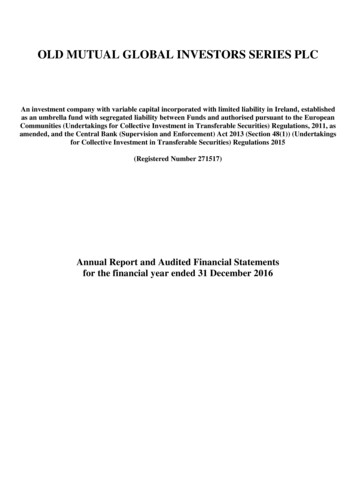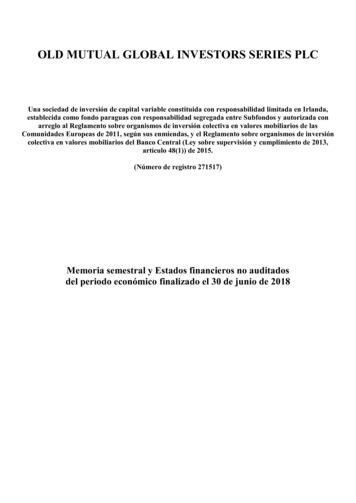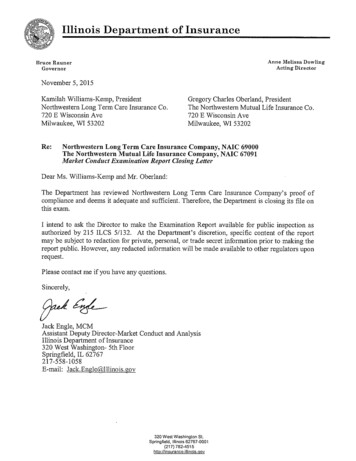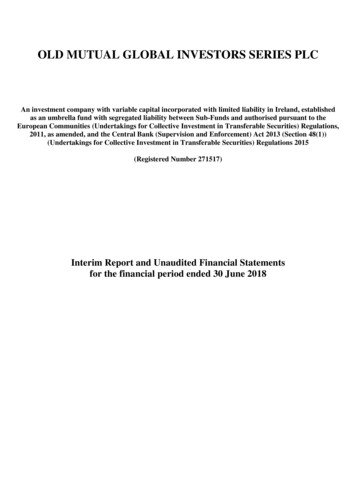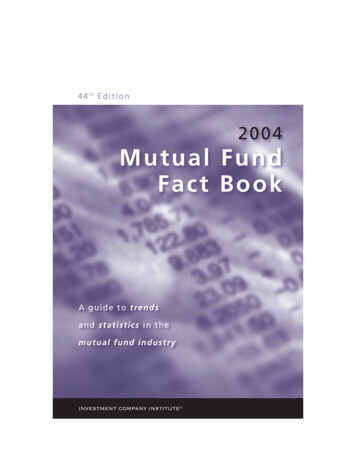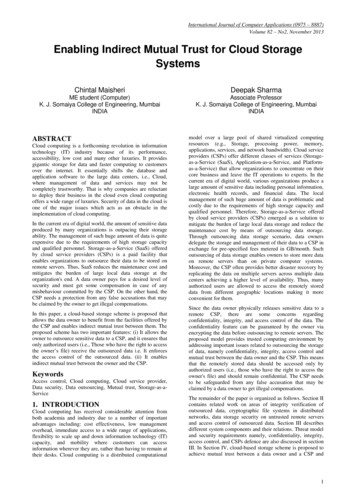
Transcription
International Journal of Computer Applications (0975 – 8887)Volume 82 – No2, November 2013Enabling Indirect Mutual Trust for Cloud StorageSystemsChintal MaisheriDeepak SharmaME student (Computer)K. J. Somaiya College of Engineering, MumbaiINDIAAssociate ProfessorK. J. Somaiya College of Engineering, MumbaiINDIAABSTRACTCloud computing is a forthcoming revolution in informationtechnology (IT) industry because of its performance,accessibility, low cost and many other luxuries. It providesgigantic storage for data and faster computing to customersover the internet. It essentially shifts the database andapplication software to the large data centers, i.e., Cloud,where management of data and services may not becompletely trustworthy. That is why companies are reluctantto deploy their business in the cloud even cloud computingoffers a wide range of luxuries. Security of data in the cloud isone of the major issues which acts as an obstacle in theimplementation of cloud computing.In the current era of digital world, the amount of sensitive dataproduced by many organizations is outpacing their storageability. The management of such huge amount of data is quiteexpensive due to the requirements of high storage capacityand qualified personnel. Storage-as-a-Service (SaaS) offeredby cloud service providers (CSPs) is a paid facility thatenables organizations to outsource their data to be stored onremote servers. Thus, SaaS reduces the maintenance cost andmitigates the burden of large local data storage at theorganization's end. A data owner pays for a desired level ofsecurity and must get some compensation in case of anymisbehaviour committed by the CSP. On the other hand, theCSP needs a protection from any false accusations that maybe claimed by the owner to get illegal compensations.In this paper, a cloud-based storage scheme is proposed thatallows the data owner to benefit from the facilities offered bythe CSP and enables indirect mutual trust between them. Theproposed scheme has two important features: (i) It allows theowner to outsource sensitive data to a CSP, and it ensures thatonly authorized users (i.e., Those who have the right to accessthe owner’s file) receive the outsourced data i.e. It enforcesthe access control of the outsourced data. (ii) It enablesindirect mutual trust between the owner and the CSP.KeywordsAccess control, Cloud computing, Cloud service provider,Data security, Data outsourcing, Mutual trust, Storage-as-aService1. INTRODUCTIONCloud computing has received considerable attention fromboth academia and industry due to a number of importantadvantages including: cost effectiveness, low managementoverhead, immediate access to a wide range of applications,flexibility to scale up and down information technology (IT)capacity, and mobility where customers can accessinformation wherever they are, rather than having to remain attheir desks. Cloud computing is a distributed computationalmodel over a large pool of shared virtualized computingresources (e.g., Storage, processing power, memory,applications, services, and network bandwidth). Cloud serviceproviders (CSPs) offer different classes of services (Storageas-a-Service (SaaS), Application-as-a-Service, and Platformas-a-Service) that allow organizations to concentrate on theircore business and leave the IT operations to experts. In thecurrent era of digital world, various organizations produce alarge amount of sensitive data including personal information,electronic health records, and financial data. The localmanagement of such huge amount of data is problematic andcostly due to the requirements of high storage capacity andqualified personnel. Therefore, Storage-as-a-Service offeredby cloud service providers (CSPs) emerged as a solution tomitigate the burden of large local data storage and reduce themaintenance cost by means of outsourcing data storage.Through outsourcing data storage scenario, data ownersdelegate the storage and management of their data to a CSP inexchange for pre-specified fees metered in GB/month. Suchoutsourcing of data storage enables owners to store more dataon remote servers than on private computer systems.Moreover, the CSP often provides better disaster recovery byreplicating the data on multiple servers across multiple datacenters achieving a higher level of availability. Thus, manyauthorized users are allowed to access the remotely storeddata from different geographic locations making it moreconvenient for them.Since the data owner physically releases sensitive data to aremote CSP, there are some concerns regardingconfidentiality, integrity, and access control of the data. Theconfidentiality feature can be guaranteed by the owner viaencrypting the data before outsourcing to remote servers. Theproposed model provides trusted computing environment byaddressing important issues related to outsourcing the storageof data, namely confidentiality, integrity, access control andmutual trust between the data owner and the CSP. This meansthat the remotely stored data should be accessed only byauthorized users (i.e., those who have the right to access theowner's file) and should remain confidential. The CSP needsto be safeguarded from any false accusation that may beclaimed by a data owner to get illegal compensations.The remainder of the paper is organized as follows. Section IIcontains related work on areas of integrity verification ofoutsourced data, cryptographic file systems in distributednetworks, data storage security on untrusted remote serversand access control of outsourced data. Section III describesdifferent system components and their relations. Threat modeland security requirements namely, confidentiality, integrity,access control, and CSPs defence are also discussed in sectionIII. In Section IV, cloud-based storage scheme is proposed toachieve mutual trust between a data owner and a CSP and1
International Journal of Computer Applications (0975 – 8887)Volume 82 – No2, November 2013hence to build trusted environment in cloud. In section V,security of the scheme is analyzed against its fulfilment ofassigned security requirements, namely, confidentiality,integrity, access control, and CSPs defence. In section VI,prototype implementation on Eucalyptus cloud computingplatform and walrus storage is presented. Finally, Section VIIsummarizes our conclusion and gives a number of future workdirections.2. RELATED WORKExisting research work can be found in the areas of integrityverification of outsourced data, data storage security onuntrusted remote servers and access control of outsourceddata.The term cloud had already come into commercial use in theearly 1990s to refer to large Asynchronous Transfer Modenetworks. By 21st century, he term ‘‘cloud computing’’ hadappeared, although major focus at this time was on Softwareas a Service (SaaS). In 1999, sales- force.com was establishedby Parker Harris, Marc Benioff. They applied manytechnologies of consumer web sites like Google and Yahoo!to business applications. They also provided the concept’s like‘‘On demand’’ and ‘‘SaaS’’ with their real business andsuccessful customers. Cloud data storage (Storage as aService) is an important service of cloud computing referredas Infrastructure as a Service (IaaS). Amazon’s ElasticCompute Cloud (EC2) and Amazon Simple StorageService(S3) are well known examples of cloud data storage.On the other side along with these benefits’ cloud computingfaces big challenge i.e. data storage security problem, which isan important aspect of Quality of Service (QoS). Once userputs data on the cloud rather than locally, he has no controlover it i.e. unauthorized users could modify user’s data ordestroy it and even cloud server collude attacks. Cloud usersare mostly worried about the security and reliability of theirdata in the cloud. Amazon’s S3 [1] is such a good example.2.1 Integrity verification of outsourced dataFor verifying data integrity over cloud servers, researchershave proposed provable data possession technique to validatethe intactness of data stored on remote sites. A number ofPDP protocols have been presented to efficiently validate theintegrity of data, e.g., [2]–[5]. Proof of retrievability wasintroduced as a stronger technique than PDP in the sense thatthe entire data file can be reconstructed from portions of thedata that are reliably stored on the servers. Juels et al. [6]Described a formal “proof of retrievability” (POR) model forensuring the remote data integrity. Their scheme combinesspot-checking and error-correcting code to ensure bothpossession and retrievability of files on archive servicesystems. Shacham et al. [7] Built on this model andconstructed a random linear function based homomorphicauthenticator which enables unlimited number of queries andrequires less communication overhead.2.2 Data storage security on untrustedremote serversCommonly, traditional access control techniques assume theexistence of the data owner and the storage servers in thesame trust domain. This assumption, however, no longerholds when the data is outsourced to a remote CSP, whichtakes the full charge of the outsourced data management, andresides outside the trust domain of the data owner. A feasiblesolution can be presented to enable the owner to enforceaccess control of the data stored on a remote untrusted CSP.Through this solution, the data is encrypted under a certainkey, which is shared only with the authorized users. Theunauthorized users, including the CSP, are unable to accessthe data since they do not have the decryption key. Thisgeneral solution has been widely incorporated into existingschemes [8]–[11], which aim at providing data storagesecurity on untrusted remote servers.Kallahalla et al. [8] designed a cryptography-based file systemcalled Plutus for secure sharing of data on untrusted servers.Some authorized users of the data have the privilege to readand write, while others can only read the data.Goh et al. [9] have presented SiRiUS, which is designed to belayered over existing file systems such as NFS (network filesystem) to provide end-to-end security. To enforce accesscontrol in SiRiUS, each data file (d-file) is attached with ametadata file (md-file) that contains an encrypted key blockfor each authorized user with some access rights (read orwrite). More specifically, the md-file represents the d-file’saccess control list (ACL). The d-file is encrypted using a fileencryption key (FEK), and each entry in the ACL contains anencrypted version of the FEK under the public key of oneauthorized user.Based on proxy re-encryption [15], Ateniese et al. [10] haveintroduced a secure distributed storage protocol. In theirprotocol, a data owner encrypts the blocks with symmetricdata keys, which are encrypted using a master public key. Thedata owner keeps a master private key to decrypt thesymmetric data keys. Using the master private key and theauthorized user’s public key, the owner generates proxy reencryption keys. A semi-trusted server then uses the proxy reencryption keys to translate a ciphertext into a form that canbe decrypted by a specific granted user, and thus enforcesaccess control of the data. Vimercati et al. [11] haveconstructed a scheme for securing data on semi-trustedstorage servers based on key derivation methods of [16]. Intheir scheme, a secret key is assigned to each authorized user,and data blocks are grouped based on users that can accessthese blocks. One key is used to encrypt all blocks in the samegroup. Moreover, the data owner generates public tokens to beused along with the user’s secret key to derive decryptionkeys of specific blocks. The blocks and the tokens are sent toremote servers, which are not able to drive the decryption keyof any block using just the public tokens. The approach in[11] allows the servers to conduct a second level of encryption(over-encryption) to enforce access control of the data.Repeated access grant and revocation may lead to acomplicated hierarchy structure for key management [17].2.3 Access control of outsourced dataThe concept of over-encryption to enforce access control hasalso been used by Wang et al. [17]. In their scheme, the ownerencrypts the data block-by-block, and constructs a binary treeof the block keys. The binary tree enables the owner to reducethe number of keys given to each user, where different keys inthe tree can be generated from one common parent node. Theremote storage server performs over-encryption to preventrevoked users from getting access to updated data blocks.Another class of solution utilizes attribute-based encryption toachieve fine-grained access control [12], [13]. However theseschemes do not implement mutual trust between the dataowner and the remote servers.Different approaches have been investigated that encouragethe owner to outsource the data, and offer some sort ofguarantee related to the confidentiality, integrity, and accesscontrol of the outsourced data. These approaches can prevent2
International Journal of Computer Applications (0975 – 8887)Volume 82 – No2, November 2013and detect malicious actions from the CSP side. On the otherhand, the CSP needs to be safeguarded from a dishonestowner, who attempts to get illegal compensations by falselyclaiming data corruption over cloud servers. This concern, ifnot properly handled, can cause the CSP to go out of business[14]. In this work, a scheme is proposed that addressesimportant issues related to outsourcing the storage of data,namely confidentiality, integrity and access control. Mutualtrust between the data owner and the CSP is anotherimperative issue, addressed in the proposed scheme. Amechanism is introduced to determine the dishonest party, i.e.,Misbehavior from any side is detected and the responsibleparty is identified. The proposed cloud-based storage schemehas the following features: (i) it allows a data owner tooutsource the data to a CSP, and it ensures that onlyauthorized users (i.e., Those who have the right to access theowner’s file) receive the outsourced data i.e. It enforces theaccess control of the outsourced data. (ii) It establishesindirect mutual trust between the data owner and the CSPsince each party resides in a different trust domain.3. OUR SYSTEM AND ASSUMPTIONS3.1 System components and relations3.1.2 Cloud service provider (CSP)Who manages cloud servers and provides paid storage spaceon its infrastructure to store the owner’s files and make themavailable for authorized users.3.1.3 Authorized usersA set of owner’s clients who have the right to access theremote data.3.1.4 Trusted third party (TTP)An entity who is trusted by all other system components, andhas capabilities to detect/specify dishonest parties.The cloud computing storage model considered in this workconsists of four main components as illustrated in Figure 1.The relations between different system components arerepresented by double-sided arrows, where solid and dashedarrows represent trust and distrust relations, respectively. Forexample, the data owner, the authorized users, and the CSPtrust the TTP. On the other hand, the data owner and theauthorized users have mutual distrust relations with the CSP.Thus, the TTP is used to enable indirect mutual trust betweenthese three components. There is a direct trust relationshipbetween the data owner and the authorized users.3.1.1 Data ownerThat can be an organization / individual generating sensitivedata to be stored in the cloud and made available forcontrolled external use.Fig 1: Cloud computing data storage system model3.2 Outsourcing and accessingFor confidentiality, the owner encrypts the data beforesending to cloud servers. To access the data, the authorizeduser sends a data-access request to the CSP, and receives thedata file in an encrypted form that can be decrypted using asecret key generated by the authorized user. It is assumed thatthe interaction between the owner and the authorized users toauthenticate their identities has already been completed, and itis not considered in this work. The TTP is an independententity, and thus has no incentive to collude with any party.However, any possible leakage of data towards the TTP mustbe prevented to keep the outsourced data private. The TTPand the CSP are always online, while the owner isintermittently online. The authorized users are able to accessthe data file from the CSP even when the owner is offline.3.3 Threat modelThe CSP is untrusted, and thus the confidentiality andintegrity of data in the cloud may be at risk. For economicincentives and maintaining a reputation, the CSP may hidedata loss, or reclaim storage by discarding data that have notbeen or is rarely accessed. On the other hand, a data ownerand authorized users may collude and falsely accuse the CSPto get a certain amount of reimbursement. They maydishonestly claim that data integrity over cloud servers hasbeen violated.3
International Journal of Computer Applications (0975 – 8887)Volume 82 – No2, November 2013Only authorized users are allowed to access the outsourceddata.The above solution increases the storage overhead on cloud asowner’s signature is stored along with the file on cloudservers. Moreover, there is an increased computationoverhead, CSP has to verify signature of owner before storingfile on cloud, and the authorized user verifies two signaturesfor each received file. If the CSP receives file from trustedentity other than the owner, the signature verification is notneeded since the trusted entity has no incentive forrepudiation or collusion. Therefore, delegating small part ofowner’s work to the TTP reduces both the storage andcomputation overheads. However the outsourced data must bekept private and any leakage of data toward the TTP must beprevented.3.4.4 CSP’s defense4.2 Notations3.4 Security requirements3.4.1 ConfidentialityOutsourced data must be protected from the TTP, the CSP,and users that are not granted access.3.4.2 IntegrityOutsourced data are required to remain intact on cloudservers. The data owner and authorized users must be enabledto recognize data corruption over the CSP side.3.4.3 Access controlThe CSP must be safeguarded against false accusations thatmay be claimed by dishonest owner/users, and such amalicious behavior is required to be revealed.4. PROPOSED FRAMEWORK4.1 Existing systemA straight forward solution to detect cheating from any side isthrough digital signatures. For each file owner attaches digitalsignature before outsourcing. The CSP first verifies digitalsignature of owner before storing data on cloud. In case offailed verification, the CSP rejects to store data and asks theowner to resend the correct signature. If the signature is valid,both the file and signature are stored on the cloud servers. Thedigital signature achieves non-repudiation from the ownerside. When an authorized user (or the owner) requests toretrieve the data file, the CSP sends file, owner’s signatureand CSP’s signature on (file owner’s signature). Theauthorized user first verifies the CSP’s signature. In case offailed verification, the user asks CSP to re-perform thetransmission process. If CSP’s signature is valid, the user thenverifies owner’s signature. If verification fails, this indicatesthe corruption of data over the cloud servers. The CSP cannotrepudiate such corruption for the owner’s signature ispreviously verified and stored by the CSP along with file.Since CSP’s signature is attached with the received data, adishonest owner cannot falsely accuse the CSP regarding dataintegrity.-F is a data file to be outsourcedh is a cryptographic hash functionK is a data encryption key/secret keyEK is a symmetric encryption algorithm under K ,e.g., AES (advanced encryption standard)E -1K is a symmetric decryption algorithm underKF is an encrypted version of the file FFHTTP is a hash value for F , and is computedand stored by the TTPFHU is a hash value for F , and is computed bythe authorized userENCS(K) is an encrypted version of secret keyunder SS is a secret shared between owner and hisauthorized users.4.3 Setup and file preparation for dataoutsourcingThe system setup has two parts: one is done on the Ownerside, and the other is done on the TTP side as shown in figure2.Fig 2: Setup and file preparation for data outsourcing4
International Journal of Computer Applications (0975 – 8887)Volume 82 – No2, November 20134.3.1 Owner role4.4 Data Access and Cheating DetectionThe data owner generates a secret key K for a file. Toachieve privacy-preserving, the owner creates an encryptedfile version F EK(F) . For access control he createsencrypted secret key ENCS(K) enables only authorized usersto decrypt secret key and access the outsourced file. Theowner sends F and ENCS(K) to the TTP, and deletes thedata file from its local storage.An authorized user sends a data-access request to both theCSP and the TTP. The authorized user receives F from theCSP and ( FHTTP , ENCS(K) ) from the TTP.4.3.2 TTP roleA small part of the owner’s work is delegated to the TTP toreduce the storage overhead and lower the overall systemcomputation. For the TTP to resolve disputes that may ariseregarding data integrity it computes and locally stores hashvalue for the encrypted file FHTTP . The TTP sends encryptedfile F to the CSP. The TTP keeps only FHTTP andENCS(K) on its local storage.4.4.1 Verification of encrypted data fileThe authorized user computes hash of encrypted file FHUreceived from the CSP and compare it with one received fromthe TTP FHTTP .If FHTTP FHU then invoke cheatingdetection procedure at TTP. And if FHTTP FHU thendecrypts ENCS(K) to get Secret Key K and hence decryptsfile. Data Access and Verification of encrypted data file isshown in figure 3.Fig 3: Data Access and Verification of encrypted data file4.4.2 Cheating detection procedureIf FHTTP FHtemp then reports “dishonest CSP and data isTTP is invoked to determine the dishonest party. The TTPreceives encrypted file F from the CSP and computestemporary hash value for encrypted file FHtemp .corrupted” to owner. If FHTTP FHtemp then reports“dishonest owner/user and data is not corrupted”. Cheatingdetectionprocedureisshowninfigure4.5
International Journal of Computer Applications (0975 – 8887)Volume 82 – No2, November 2013Fig 4: Cheating detection procedure5. SECURITY ANALYSIS5.1 Data confidentialityThe outsourced data are kept secret; the data owner creates anencrypted version of the data file F . The encryption of a fileis done using a secret key K generated by owner, where Kis accessed only by the data owner and the authorized users.5.2 Detection of data integrity violationDue to preimage and second-preimage resistance properties ofthe used cryptographic hash function h along with the noncollusion incentive of the TTP, the data cannot be corruptedon cloud servers without being detected. During the dataaccess phase of the proposed scheme, the authorized userreceives the encrypted file from the CSP and FHTTP from theTTP. The authorized user computes hash of encrypted fileFHU and compares FHTTP and FHU .If FHTTP FHU , then F has been corrupted on the server.For violating data integrity without being detected there aretwo possible scenarios. First, the CSP has to send a file F'where F' F but h (F') h (F) . Due to the second-preimagedata, and thus the access control is achieved in the proposedscheme.5.4 Detection of dishonest owner/userIf the owner/user falsely accuses the CSP regarding dataintegrity, the TTP performs cheating detection procedure. Inthis procedure, TTP retrieves encrypted file from CSP andcomputes the temporary hash value FHtemp and comparesFHTTP and FHtemp . If FHTTP FHtemp , then F has not beencorrupted on the server and owner/ user is dishonest.5.5 Detection of dishonest CSPDuring the data access phase of the proposed scheme, theauthorized user receives the encrypted file F from the CSPand FHTTP from the TTP. The authorized user computes hashof encrypted file FHU and compares FHTTP and FHU .If FHTTP FHU , a report is issued to TTP to determine thedishonest party. The TTP retrieves encrypted file from CSPand computes the temporary hash value FHtemp and comparesresistance property of h , there is no such a file F' . Second,FHTTP and FHtemp . If FHTTP FHtemp , then F has beencorrupted on the server and CSP is dishonest.the CSP has to generate h (F') such that FHTTP h (F') and6. IMPLEMENTATIONh (F') h (F) . If CSP could create file F' with h (F') , thecheating is possible. Due to the preimage-resistance propertyof h (one-way function), the CSP cannot generate such a fileF' .The proposed scheme is implemented on Eucalyptus Cloudcontroller and walrus storage service cloud platform. Theimplementation of the proposed scheme consists of threemodules: OModule (owner module), UModule (user module),and TModule (TTP module).5.3 Enforcement of access controlThe owner creates ENCS(K) and only authorized users candecrypt ENCS(K) using S and get K to read the outsourcedUModule is a library to be run at the authorized users’ side,and include functionalities that allow users to interact with theTTP and the CSP to retrieve and access the outsourced data.6
International Journal of Computer Applications (0975 – 8887)Volume 82 – No2, November 2013OModule, which runs on the owner side, is a library to beused by the owner to perform the owner role in the setup andfile preparation phase.TModule is a library used by the TTP to determine thecheating party in the system.6.1 Implementation settingsIn implementation, a laptop HP-630 with Intel Core i52540M (2.60 GHz, 3 MB L3 cache) processor and 4 GBRAM running Cent OS 2.6.32-358.2.1.el6.x86 64 is used forinstallation of Eucalyptus 3.2.1 cloud.A laptop with Intel Pentium(R) Dual CPUT3200@2.00GHz 2 processor and 2GB RAM runningUbuntu 12.04 LTS operating system is used to execute theUModule and OModule.A separate server in the lab is used to run TModule. Thisserver has Intel Core i5-2430M, 2.40 GHz processor,4GB RAM, and Ubuntu 12.04 LTS operating system.Algorithms (hashing, Advanced Encryption standard) areimplemented using crypto library.Fig 6. User Interaction with Eucalyptus-Walrus6.3 Eucalyptus account login screenSystem setup is as shown in figure 5.Fig 5: System setup6.2 User Interaction with EucalyptusWalrusA Eucalyptus user/client has to provide his SECRET KEYand ACCESS KEY while requesting access to buckets andobjects. An architectural diagram of Walrus is given in Figure6; user can access Walrus storage via REST/SOAP API whilethe cloud controller provides access control to Walrus objectsusing ACLs and user credentials.7
International Journal of Computer Applications (0975 – 8887)Volume 82 – No2, November 20136.4 Eucalyptus Dashboard Screen6.5 TTP Results6.5.1 Setup and file preparation for dataoutsourcingTTP authenticates owner before receiving an encrypted file,an encrypted key and list of users who has access to file fromowner. After successful authentication, TTP calculates hash offile and uploads file on cloud on behalf of owner and storeshash and an encrypted key in TTP DB.8
International Journal of Computer Applications (0975 – 8887)Volume 82 – No2, November 20136.5.2 Data Access and Cheating Detection6.5.2.1. User successfully downloads file.6.5.2.2 Cheating detection procedure is invoked.9
International Journal of Computer Applications (0975 – 8887)Volume 82 – No2, November 20137. CONCLUSIONThe cloud based storage scheme is proposed that allowsowner to benefit from facilities offered by the CSP andenables indirect mutual trust between them. It enables dataowners to release their concerns regarding confidentiality,integrity, access control of the outsourced data. To resolvedisputes that may occur regarding data integrity, a trustedthird party is invoked to determine the dishonest party(owner/users or CSP).The security features of the proposed scheme are studied, andshowed that the scheme satisfies: (i) data confidentiality basedon the security of underlying encryption algorithm, (ii)detection of data integrity violation based on the preimage andsecond-preimage resistance properties of the utilizedcryptographic hash function, (iii) enforcement of accesscontrol based on, TTP gives encrypted key to only authorizedusers and only authorized users can decrypt this key and getthe key to read the outsourced data; and (iv) detection ofdishonest owner/user through a trusted third party.8. FUTURE RESEARCH DIRECTIONSThe area of cloud computing has attracted many researchersfrom diverse fields; however, much effort remains to achievethe wide acceptance and usage of cloud computingtechnology. A number of future research directions stem fromour current research. Below, we summarize some problems toaddress during our future research.8.1 User authentication for cloud computingsystemsThe development of cloud computing encourages the use ofresource-constrained devices (PDA/cell phones) on the clientside. Thus, rather than local data storage and softwareinstallation, users will be authenticate to access data and useapplications from the cloud. Such computing model makessoftware piracy more difficult and enables centralizedmonitoring. Although cloud computing architecture stimulatesmobility of users, it increases the need of secureauthentication.Relying on passwords for user authentication is not anefficient approach for sensitive data/applications on the cloud.Passwords is a major point of vulnerability in computersecurity; they are often easy to guess by automated programsrunning dictionary attacks, users cannot remember very longpasswords, and the common use of meaningful passwordsmakes them subject to dictionary attacks.Implicit authentication is another interesting area of researchto address user authentication problem. One can use learningalgorithms to construct a model for the user based on previousbehavior patterns, and then compare the recent behavior withthe user model to authorize legitimate users
as Infrastructure as a Service (IaaS). Amazon's Elastic Compute Cloud (EC2) and Amazon Simple Storage Service(S3) are well known examples of cloud data storage. On the other side along with these benefits' cloud computing faces big challenge i.e. data storage security problem, which is an important aspect of Quality of Service (QoS).

